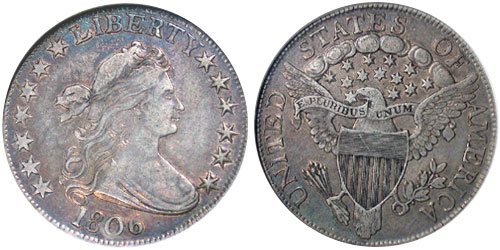Draped Bust Half Dollar
Source: My Coin Guides: The Draped Bust Half Dollar was struck between the years 1796 and 1807 with two different reverses. When considered separately, the first reverse issued from 1796 to 1797 featuring a small eagle is considered one of the most famous types in all of American numismatics due to its rarity. The second reverse issued from 1801 to 1807 featuring the heraldic eagle is more available due to higher mintages. Virtually all dates for the series are scarce to very rare in uncirculated condition.

The main objective of the early United States Mint in Philadelphia was not only to turn out an adequate supply of copper, silver, and gold coinage, but also to make them more or less similar in appearance. The design that was introduced on the various denominations in 1796 was created by Robert Scot, first Chief Engraver of the United States Mint, based on work by Gilbert Stuart. It is believed, although not proven, that the image used to design Liberty was based on a portrait of the Philadelphia woman Ann Willing Bingham. A Gilbert Stuart sketch of Bingham at age 21 is pictured below.
 The obverse of the Draped Bust Half Dollar features the head of Liberty, facing right. The partially visible bust is draped, hence the name given to this design in the 19th century, which continues to be used today. The word LIBERTY appears above, and the date appears below. An arrangement of stars appear behind and in front of Liberty.
The obverse of the Draped Bust Half Dollar features the head of Liberty, facing right. The partially visible bust is draped, hence the name given to this design in the 19th century, which continues to be used today. The word LIBERTY appears above, and the date appears below. An arrangement of stars appear behind and in front of Liberty.
The half dollars issued in 1796 had either fifteen or sixteen stars. The additional star was added after Tennessee became the sixteenth state of the Union in June 1796. Interestingly, the 1797 half dollars once again featured only fifteen stars, followed by a gap in production. When the denomination resumed in 1801 only thirteen stars were used to represent the original thirteen states in the Union.
The initial reverse design for Draped Bust Half Dollars features a modified reverse based on earlier work by Scot, which had previously been used for half dimes, half dollars, and silver dollars from 1794 and 1795. An American Bald Eagle is pictured at center, encircled by a wreath with the top slightly open. The eagle is seen standing on clouds, just above a ribbon which holds together both sides of the wreath. Beneath the ribbon is the fraction “1/2” to indicate the value of the coin. The words UNITED STATES OF AMERICA surround at the rim. This is the so-called “small eagle” reverse used for coins dated 1796 and 1797.
The denomination was not produced again until 1801. During the hiatus, a new reverse design had been introduced the other silver denominations, which would be adopted for the half dollar as well. The reverse used from 1801 to 1807 is known as the “heraldic eagle” reverse. The eagle is viewed from the front with wings and claws spread. One of the eagle’s talons grasp a bundle of arrows and an olive branch, while its beak hold a ribbon with the inscription E PLURIBUS UNUM. Thirteen stars and an arch of clouds appears above the eagle. The words UNITED STATES OF AMERICA encircle the image, with the denomination indicated on the edge of the coin.
